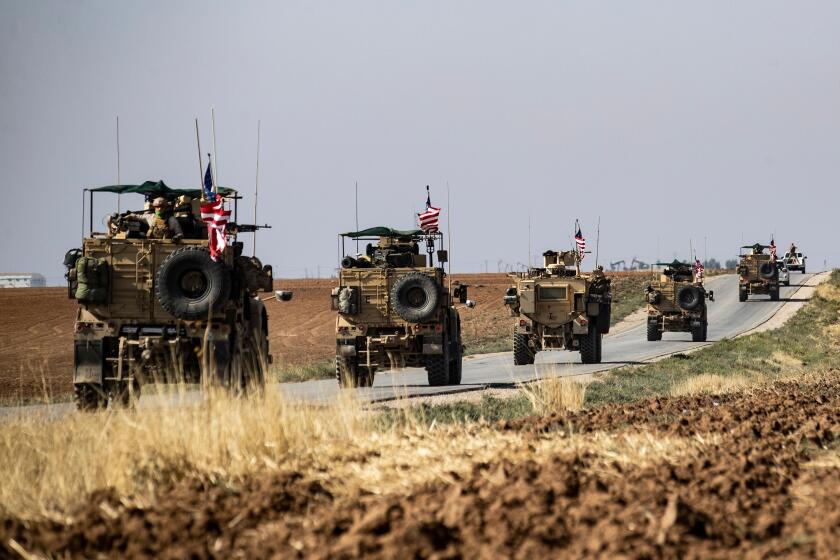China deepens ties to Middle East as Trump downsizes U.S. role
- Share via
BEIJING — As President Trump eyes the exit in the Middle East, his critics have excoriated him for abdicating a strong U.S. role in the region and clearing a path for Russia’s dominance. Yet in their scramble to find new allies, regional states have also turned to a quieter but no less powerful U.S. rival: China.
Syrian President Bashar Assad signaled China’s rising influence in the region this week when he announced plans to join the Belt and Road initiative, President Xi Jinping’s signature foreign policy enterprise. But even before that, China had planted its flag in practically every country in the Mideast.
It now stands as the region’s largest investor and expects to cement that status with Belt and Road, a sprawling, $1-trillion infrastructure project meant to revive the ancient trading routes of the Silk Road — including those linking China to Central Asia and the Middle East (or West Asia, as Beijing calls it).
Within the framework of that initiative, China has signed trade agreements with countries from Oman to Morocco, harnessing Arab capital for development projects to build up railroads, ports and electricity infrastructure across the region.
All this comes against the backdrop of a rising U.S.-China rivalry, exemplified by a yearlong trade war, saber-rattling in the western Pacific and a race for influence in Latin America and Africa. Flying largely under the radar, Beijing has had great success in drawing Middle Eastern nations into its orbit at a time when President Trump is seen region-wide as a mercurial ally, if one at all.
President Trump’s Syria withdrawal, decided after a single phone call, has been a gift to Russia and ISIS while it has worried Israel, other allies.
“The United States has become consistently inconsistent.… Regional players, including friends of the United States, increasingly view Washington as an unreliable partner,” said Anubhav Gupta, associate director of the Asia Society Policy Institute.
“They are forming stronger ties with other major powers because they sense both an uncertainty about U.S. commitment to the region as well as a lack of clarity as to what position the U.S. will take from one moment to the next.”
By contrast, there has been little question of Beijing’s commitment.
Chinese foreign direct investment has steadily increased over the last 10 years, with Beijing emerging as a major player in energy purchases, with the region meeting more than 40% of the Asian giant’s energy needs.
“Just buying oil, shifting the supplies of oil, would have huge impact on the economy of the gulf and the region,” said Andrea Ghiselli, coordinator of ChinaMed, an Italian-Chinese research project focusing on China’s role in the Mediterranean region.
President Trump has ordered U.S. forces to secure oil fields in northeastern Syria and has said the United States will keep the oil. But there was never that much oil in Syria, and nearly a decade of civil war has badly damaged the country’s capacity to exploit it.
China has also had success presenting itself as a pragmatic partner, one whose foreign policy is characterized by a self-avowed commitment to national sovereignty and non-interference in other countries’ domestic affairs. The attitude squares well with authoritarian governments in the region, which can do business with China without Beijing criticizing their human rights records or undemocratic systems.
That stance has also enabled Beijing to maintain relationships on all sides of long-standing Middle Eastern rifts, such as those between Iran and Saudi Arabia; Israel and the Palestinian territories; and one pitting Turkey and Qatar against a number of other Persian Gulf nations.
The pragmatism has worked both ways. Despite widespread condemnation of China’s domestic policies toward Muslim minorities, including the internment of more than a million Uighur Muslims in the Xinjiang region, nine Arab countries — Saudi Arabia, Syria, Oman, Kuwait, Algeria, Egypt, Bahrain, Qatar and the United Arab Emirates — signed a letter to the United Nations in July defending China’s Xinjiang policies. Qatar later was reported to have rescinded its support.
“Nobody can be more concerned about the status of Muslims anywhere in the world than Saudi Arabia,” Abdallah al-Mouallimi, the Saudi ambassador to the U.N., told reporters in New York in July. “We support the developmental policies of China that have lifted people out of poverty.”
Beijing’s willingness to make deals where Washington does not tread has been a draw for the United States’ regional adversaries, such as Assad.
With the help of Iran and Russia, Assad has emerged as the victor — at least militarily — of the eight-year civil war that began in 2011. But with much of his country destroyed, and escalating economic U.S. sanctions crippling access to Western funds, he has courted Beijing to jump-start a prospective reconstruction bonanza.
“Today, we see that there is a superpower, China, trying to strengthen its influence in the world,” Assad said in an interview with China’s Phoenix Television on Monday. He added the government had proposed six projects that would fit in with the Belt and Road initiative.
“It is not the negative influence we have become accustomed to, but rather an influence in the sense of relying on friends and an influence based on mutual interests,” he said.
As part of its engagement, Beijing has made inroads in supplying weapons to the region. The area is awash with older, Chinese-made light weapons that have found their way across the Middle East, with Beijing supplying bullets and rockets to various governments.
China’s overall arms exports to the region are still minuscule in comparison with those of the United States and Russia, especially when it comes to heavier weapons and defense systems. But China dominates in the export of unmanned combat aerial vehicles (UCAVs) or armed drones to Middle Eastern countries facing restrictions on drone sales from the United States.
Between 2014 and 2018, China exported 153 UCAVs to 13 countries, including Egypt, Iraq, Jordan, Saudi Arabia and the Emirates, according to the Stockholm International Peace Research Institute, and they have made their way to battlegrounds as far afield as Libya. The United States exported only five in the same period, all to the United Kingdom.
Fifty-two percent of U.S. arms exports, which are seven times larger than Chinese exports globally, go to the Middle East, according to the Stockholm institute. China mainly exports arms to Asia and Oceania, with the Middle East accounting for only 6.1% of Chinese weapons exports from 2014 to 2018.
Despite the shrinking U.S. presence in the region, it’s unclear how far Beijing will go to fill the vacuum, especially given the tenuous state of U.S.-China relations and the unrest in Hong Kong. It would also require astronomical financial and military costs at a time when China’s economy is slowing.
“China still lacks the willingness and capacity to play the U.S. role of regional cop,” Gupta said.
Ghiselli agreed.
“Behind these win-win rhetoric and partnerships,” he said, “everyone knows there is a limit of what China can do and what China is willing to do.”
Su reported from Beijing and Bulos from Beirut.
More to Read
Sign up for Essential California
The most important California stories and recommendations in your inbox every morning.
You may occasionally receive promotional content from the Los Angeles Times.














